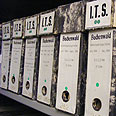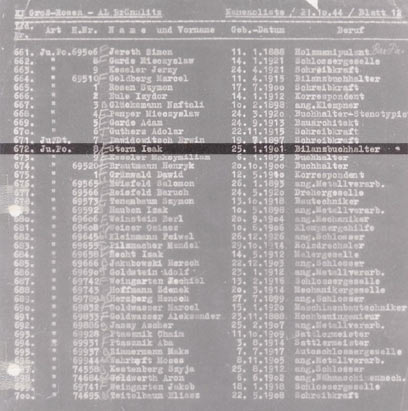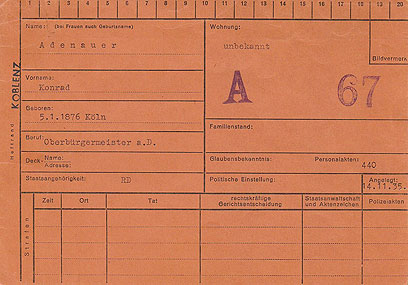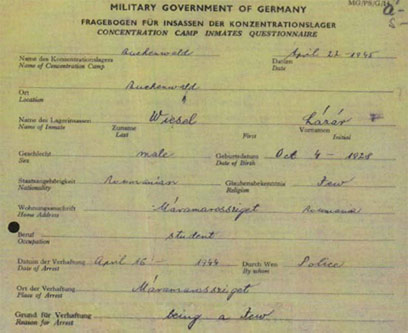
Satan's administration: Journey into Nazi death records
Daily food intake of Aushchwitz prisoner, original Schindler's list, names of children on Exodus, blood-curdling account of millions of those murdered – and overwhelming response to deniers. Dor Glick takes trip among shelves of largest archive in world of Nazi horrors, and receives chilling greeting from his grandmother who survived and her brother who didn't
BERLIN - Welcome to Grosse Allee 5 in the town of Bad Arolsen. Here you will find just one thing: documents. Fifty million card cabinets containing the names of 17.5 million people who were persecuted during the Third Reich. Gypsies, social democrats, homosexuals, communists, people the Nazis just wanted to have taken care of, and mainly - Jews.
Walking through the shelves of names organized in little card catalogues is a bit like flipping through a phone book. The place is flooded with familiar Jewish names. For a random family name like Abramovich, for instance, there are 849 spelling variations. As the shelves continue, you come across additional familiar names with similar numbers of spelling options. The inconceivable number – six million – starts to come into focus. The adage from Holocaust memorial ceremonies – to each person a name – takes shape, typed in black on the shelf.

Each name has a card. Bad Arolsen (Photo: Dor Glick)
"Satan's administration" is what Udo Jost, the head of archives at Bad Arolsen, calls the world's largest archives of the Nazi horrors. The documents housed here were found in thick binders throughout Germany and occupied Europe starting in 1945, and include records of factory-like operations that had to show production and expediency. In them are descriptions of the camps, of the deranged plans, of those who remained alive, and of the enormous majority that did not survive.
The archive is not complete. In the last months of the war, with defeat quickly approaching, the Nazis launched a mass campaign to destroy documents, which took place mainly in locations that had time to rid of them. The farther east you go on the map, the more documentation was destroyed. From Sobibor, for instance, nearly nothing remains. However, fortunately for history's sake and the sake of defending against Holocaust deniers, a massive scale of material remains here as testimony. About Buchenwald and Dachau, you can find out everything in Bad Arolsen – what they received to eat on a given day, how many lice were on the head of a given inmate, etc.
All of this plunder was collected by conquered Germany's new masters: the Americans, Soviets, British, and French. At first, the city of Kassel, in the center of the country, was chosen for the collection point of all the material. However, Kassel was totally destroyed in the bombings and lacked sufficient intact infrastructure. Not far from there was an abandoned SS headquarters, which had good telephone and telegraph connections vital for the organization's operations. Thus, the International Tracing Service, originally charged with locating displaced persons scattered across Europe, arrived in Bad Arolsen.
Support for birthing racially pure descendents
A tour of one of the rooms with Kathrin Flor, the head of ITS communications, is a lesson in history unlike any other. In the space of mere meters, without the grandiose display of a museum, the most tragically interesting stories of the 20th century can be found.
One gray binder, for instance, contains a document entitled "Lebensborn", the document entering into force the Nazi organization responsible for encouraging and supporting Aryan births by pairing "racially pure" women with SS officers, and later by transferring blonde-haired, blue-eyed children from eastern Europe to Aryan German families within the boundaries of the Reich. Along the grey text of the typewriter, hand-written corrections can be seen, corrections made in pen that are amazingly preserved and look as though they were written just last week. The corrections were made by none other than SS leader Heinrich Himmler.
This is what can be read today on the businesslike document:
The committee operates in support of the following objectives:
1. Creation of families with many biologically and racially pure children
2. Support for single mothers that can bring biologically and racially pure children into the world
3. Support for such children
Signed: Heinrich Himmler Date: 24.12.1937
Jumping seven years ahead in time, the next binder delves the reader deep into the period of the most wide-scale, systematic murder known to humanity. The document is dated October 12, 1944 and listed under the anemic title "List of Names" containing the personal details of 1,000 people - 700 men and 300 women, all Jews. Number 672 on the list: Yitzhak Stern, Profession: Accountant. This is the original Schindler's list. (To view the full list, click here)
However, unlike in the Oscar-winning movie, there aren't any sophisticated effects, like a little girl wearing a red coat in a black and white movie. The original is realistic, colorless, and light-years away from Hollywood's translation onto the silver screen. As I go through some of the names on the list, Katherin Flor looks around the room and says, "While this list became famous, it is actually just one of thousands that we have here in the archives. Each list has its own story."

At 672, Yitzhak (Isak) Stern. The original Schindler's list (Photo: ITS)
An interesting detail for those who like the movie: The list typed up by Yitzhak Stern himself as re-enacted in the Steven Spielberg's movie did not survive the war. The historical information surrounding Schindler's List comes from testimonies given by the factory workers. The list in the archive today was typed up by one of Schindler's employees, during one of the transfers between camps. He gave the only copy he managed to keep to the archive in Bad Arolsen in 1958.
Other documents carry enormously weighty importance when confronting various distorted and false claims related to the Holocaust. For instance, the claim that the average German would not have necessarily known about the forced labor camps and what was taking place in them. To this end, Flor took out a book listing prisoners at Dachau and Buchenwald. On a daily basis, it was listed precisely where each one of the thousands of prisoners worked – in which village, town, or German city he was forced to work in, dressed in prisoners' garb.
"Residents throughout Germany could not help but to see who arrived to perform forced labor next to them, and for an extended period of time," she said. "This little book cancels any possibility for feigning innocence and lack of knowledge."
Details down to the margarine
"Speisezettel – Auschwitz" is written on another document randomly pulled from the shelf. It is the list of food the prisoners who passed the selection received in the notorious Auschwitz death camp. For instance, on Monday 7.12.1942, a "hard laborer" in Auschwitz received 450 grams of bread, 30 grams of margarine, and 125 grams of cheese. If you open the "menu" to two years later, this measly ration seems like a dream come true.
Moving on down the corridor: a brown card of the Nazi secret police, the Gestapo. Already in November 1935, the Gestapo sought to keep a watchful eye on a young German man suspected of "involvement in separatist activities." Last name: Adenauer. First name: Konrad. Seventeen years later, he was the statesman who signed the Reparations Agreement between West Germany and the State of Israel.

Keeping an eye on Konrad Adenauer (Photo: ITS)
And it continues. The list of children who boarded the ship Exodus, documents identifying Ivan Demjanjuk that are currently being used in court. The fluorescent-light-flooded room does not cease to amaze. After a seven-hour visit, I am left with the feeling that I only got a small taste.
Beyond the vast historical interest such a place holds, no less important is what the archive provides on an individual basis for Holocaust survivors, as well as the second and third generation, who now can check with ease and accuracy impossible in the past what happened to their families. This is performed through the International Tracing Service located in Bad Arolsen.
The uncle whom mom never met
On April 22, 1945, the prisoner Rachmin Feingold died in the Dachau concentration camp. The letters Sch-J are listed on his card. The archive staff, fluent in the Nazi bureaucratic language, translated the shorthand – "Prisoner without rights" Reason for being held: "Jewish."
What did 22-year-old prisoner Feingold die from? This is not listed on Dachau's death list. Apparently from hunger. Just a week later on April 29, the American military arrived at the site and liberated the camp. Rachmin (Yerachmiel) Feingold is my grandmother's brother, the uncle my mother will never meet.

Chilling family records. Dor Glick
In Bad Arolsen, I received his death certificate, the possibility to see precisely where he died and to know for the first time the date it happened, just seven days before liberation.
The level of detail and documentation is astounding. Prisoner A-24652 was brought to Auschwitz in the transport on August 19, 1944, a day after her 16th birthday. This prisoner is my grandmother. She was lucky enough to pass the selection. Fortunately, 16 was an age at which it was somehow still possible to survive in Auschwitz.

Elie Wiesel's record. 'Reason for arrest: Being Jewish' (Photo: ITS)
The last documentation of the masses of people who arrived in Auschwitz and subsequently sent to their deaths is the list of transports that arrived in the camp. For those who arrived in the camp and were first sent to forced labor, and only afterwards to their death, the cause of death is listed as "heart attack" or "pneumonia."
The Nazi obsession with keeping records spared just one detail. In no list of deaths in all of Bad Arolsen will you find the word "gas."
Those who wish to browse through the archives can visit Bad Arolsen or send inquiries via email. The Yad Vashem Holocaust Museum, which works in close cooperation with the Bad Arolsen archives, holds several copies of the original document.
Both websites, as well as the Holocaust Memorial Museum in Washington DC, share an impressive computerized database, but searching through it can be difficult. So, the Bad Arolsen archive offers personal assistance to visitors.
The archive was first opened to the public in 2007. If it were moved to Berlin, it would instantly become a must-see site for tourists visiting the city – certainly for Israelis. But it is located a four-hour drive from the German capital, far from any city of interest. Because of this, far too many people do not even know of its existence.
Flor, who holds a Masters Degree in History, and moved to the city in order to work in the archives, would like to change this. "I lived for one year in Israel, and this period left me with the great desire to help those who suffered under the Nazi regime. The past I can't change, but if I can do anything for the survivors and their families in the present, this is the main reason I am here."
In the meantime, the lack of awareness is notable. In 2009, just nine Israelis visited the archives, which can provide such important information to so many people. The total number of telephone and internet inquiries made from Israel was 528, putting Israel eighth on the list of incoming inquiries. Flor summarized, "Many more requests are received here from Holland than from Israel regarding the fate of those who perished and of survivors."










